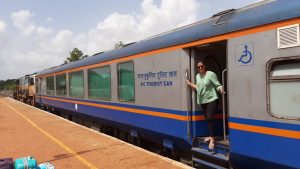
Indian Railways is one of the largest and busiest rail networks in the world, transporting millions of passengers daily. Due to high demand, especially during peak travel seasons, many passengers find themselves on the General Waiting List (GNWL) when booking train tickets. Understanding how waiting list confirmations work can help passengers plan better and increase their chances of securing a confirmed seat.
GNWL confirmation chances, the factors influencing it, and tips to improve the likelihood of getting a confirmed ticket.
What is a General Waiting List (GNWL)?
A General Waiting List (GNWL) ticket is issued when all reserved seats in a train are fully booked. Instead of a confirmed seat or berth, passengers are given a waiting list number. This number indicates their position in the queue for a confirmed ticket, should cancellations occur.
For instance:
GNWL/10 means the passenger is 10th in line for a confirmed ticket.
GNWL is typically assigned to passengers booking tickets from the originating station or an important intermediate station. It has the highest priority among all types of waiting lists when it comes to confirmation.
Factors Influencing GNWL Confirmation Chances
Several factors determine whether a GNWL ticket will get confirmed. These include:
- Quota Availability
Indian Railways allocates seats under various quotas (e.g., General, Ladies, Senior Citizen, Tatkal).
GNWL tickets fall under the General Quota, which usually has the largest allocation of seats.
If a train has a higher General Quota, GNWL tickets have a better chance of confirmation.
- Train Popularity and Route
Popular trains on high-demand routes, such as Rajdhani, Shatabdi, or Vande Bharat, are often booked quickly, reducing confirmation chances.
However, less popular trains or those running on less congested routes may have a higher likelihood of GNWL confirmations.
- Season and Timing
Peak Seasons: During festivals, holidays, or wedding seasons, confirmation chances drop significantly due to increased demand.
Off-Peak Seasons: During lean travel periods, GNWL tickets are more likely to get confirmed.
- Number of Cancellations
Cancellations by other passengers play a significant role in GNWL ticket confirmation.
The higher the cancellation rate, the better the chances of GNWL movement.
- Booking Time
Tickets booked earlier have a higher likelihood of confirmation.
Last-minute bookings are less likely to get confirmed.
- Coach Composition
Trains with a higher number of coaches, particularly reserved ones, have more seats, which increases the chances of GNWL confirmation.
Priority of GNWL Over Other Waiting Lists
GNWL has a higher priority over other types of waiting lists, such as:
RLWL (Remote Location Waiting List): For intermediate stations; lower confirmation chances.
PQWL (Pooled Quota Waiting List): For passengers boarding and alighting at different stations; medium priority.
TQWL (Tatkal Quota Waiting List): Tatkal bookings; very low chances.
When cancellations occur, GNWL tickets are considered first for confirmation.
Confirmation Chances by Waiting List Number
While there’s no official formula to determine confirmation, historical data suggests the following probabilities:
GNWL 1-10: Very high chance of confirmation.
GNWL 11-20: High chance, especially if booked early.
GNWL 21-50: Moderate chance; depends on the train, route, and cancellations.
GNWL 51 and above: Low chance, especially for popular trains or peak seasons.
How to Check GNWL Confirmation Chances
Indian Railways offers several tools to estimate waiting list confirmation probabilities:
IRCTC Website/App: Provides live updates on ticket status.
PNR Prediction Tools: Third-party apps like ConfirmTkt and Trainman predict confirmation chances based on historical data.
Chart Preparation: Final confirmation status is revealed after the reservation chart is prepared, usually 3-4 hours before departure.
Tips to Increase GNWL Confirmation Chances
Book Early:
Reserve tickets as soon as booking opens (120 days before travel).
Choose Trains with Lower Demand:
Opt for less popular trains or alternative routes.
Avoid Peak Times:
Travel during weekdays or off-peak seasons for better chances.
Monitor Ticket Status:
Regularly check the status of your waiting list ticket.
Upgrade to Tatkal or Premium Tatkal:
If confirmation seems unlikely, book under Tatkal or Premium Tatkal quotas.
What Happens if GNWL Tickets Don’t Get Confirmed?
If a GNWL ticket remains unconfirmed:
For e-tickets (booked via IRCTC): The ticket is automatically canceled, and the fare is refunded.
For counter tickets: Passengers need to cancel the ticket manually to receive a refund.
Unconfirmed GNWL tickets are not valid for travel.
The confirmation of General Waiting List (GNWL) tickets depends on several dynamic factors, including the route, season, and cancellations. While GNWL has the highest priority among waiting lists, passengers should still plan ahead and monitor their ticket status closely. By booking early and considering alternative trains or routes, passengers can improve their chances of securing a confirmed seat.
Understanding these nuances empowers passengers to navigate the complexities of Indian Railways bookings more effectively, ensuring a smoother travel experience.

Leave a Reply